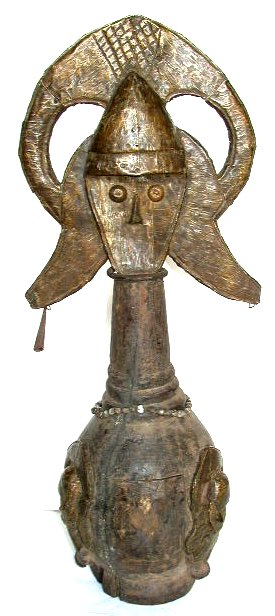 Kota
(Akota, Bakota, Kuta), Gabon and Republic of Congo
Kota
(Akota, Bakota, Kuta), Gabon and Republic of Congo
Reliquary
bwete figure. Several
ethnic groups termed “Kota” use this kind of abstract figures as guardians for
ancestral bone relics kept wrapped in baskets or bark boxes. Historically, the Kota left
their dead unburied in the forest far from the village. Under the influence
of neighboring tribes, they then began to bury their dead. Chiefs were always buried,
but often their bones (especially the skull) were later exhumed and placed with magical
objects (shells, seeds, fruits) in a bark box or a basket called a bwete,
on the top of which a carved figure was placed. These figures are unusual in African
representation of the human head because of its flat, two-dimensional character. The head
rests on a column, which is supported by a body decorated with traditional images with
lozenge shaped legs. The semicircular top is considered as headdress. Kota rituals allied
to ancestor cults aimed to honor illustrious deceased members of the lineage, but also
would carefully keep them out of reach of other villagers. Terms such as abstraction or
realism are inappropriate here, for this is an example of the most extreme stylization.
Material:
wood, metal sheeting
Size: 29½”x11½”x8”

